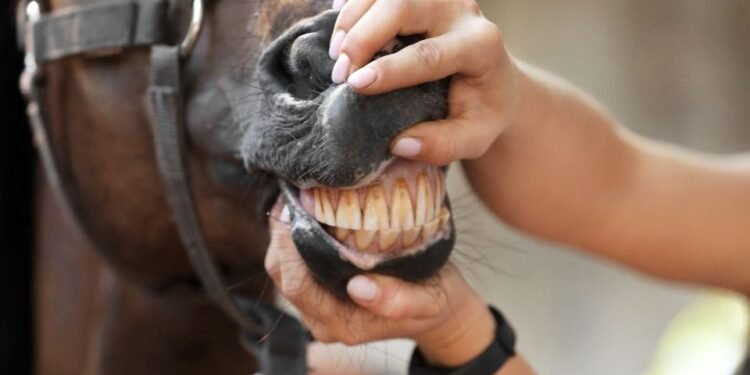Horses, those majestic creatures that have long been our faithful companions in work and leisure, boast an intriguing dental anatomy that can tell us much about their age and overall health. If you’ve ever wondered, “Do horses have teeth?” The answer is a resounding yes. This article will shed light on the fascinating world of equine dentition, exploring the different types of horse teeth and their roles in a horse’s life.
Let’s begin our journey by looking into your horse’s mouth. Remarkably, an average horse possesses between 36 and 42 teeth, a count influenced by factors such as the horse’s sex and the presence of extra teeth along the bars of the mouth. These additional teeth often reside in the space between the front and rear teeth, precisely where the bit rests.
Do Horses Have Teeth?: Types of Horse Teeth
Much like humans, horses undergo two distinct stages of dental development throughout their lives, each marked by different types of teeth. These stages are the deciduous (baby) and permanent (adult) teeth.
Deciduous (Baby) Teeth
The deciduous teeth, often referred to as baby or milk teeth, constitute the initial set of teeth that sprout within a foal’s mouth. In some cases, these tiny teeth might already be visible when the foal is born. However, these baby teeth don’t stick around for long. As the young horse approaches its second birthday, they are gradually displaced by the emergence of permanent adult teeth.
In total, a foal’s mouth is graced with 24 deciduous teeth. These baby teeth play a crucial role in the horse’s early stages of life. They enable the foal to nurse, providing the essential nutrition for growth and development. Nonetheless, by the time the horse reaches approximately five years of age, the deciduous teeth have typically been replaced entirely by their permanent counterparts.
Occasionally, a young horse may encounter difficulties shedding its baby teeth, known as “caps.” In such instances, intervention by a veterinarian or equine dentist becomes necessary to assist in removing these retained baby teeth. Failure to do so can result in discomfort and potential dental issues down the road.
Permanent Teeth
The permanent teeth, often referred to as adult teeth, continue to grow and evolve throughout most of a horse’s life. These are the teeth we rely on to gauge a horse’s approximate age, akin to counting the rings of a tree trunk. As a horse advances in years, the growth of these permanent teeth gradually ceases, and the horse may develop noticeable gaps where teeth have fallen out.
This cessation of tooth growth, a sign of the horse’s aging process, can result in various issues. One common problem is weight loss, which may be attributed to the horse’s reduced ability to properly masticate its food. In more severe cases, horses may exhibit quidding, where they drop partially chewed feed from their mouths during meals.
It’s important to note that aging a horse by examining its teeth is not an exact science but a valuable indicator. Equine dental experts and veterinarians can assess the horse’s dental wear patterns and the presence or absence of specific teeth to estimate its age. These patterns can provide a wealth of information to conscientious horse owners and caretakers.
Conclusion: Do Horses Have Teeth?
In summary, horses have teeth, and their dental anatomy is a fascinating subject for equine enthusiasts and professionals. A horse’s mouth houses two distinct sets of teeth throughout its life: deciduous (baby) and permanent (adult) teeth. While the baby teeth serve essential functions early in life, they eventually make way for permanent teeth, which continue to evolve.
So, the next time you find yourself gazing into your horse’s mouth, take a moment to appreciate the intricate world of equine dentition and the valuable insights it can offer into your horse’s life and health. After all, horses may not be known for their smiles, but their teeth have stories to tell.




